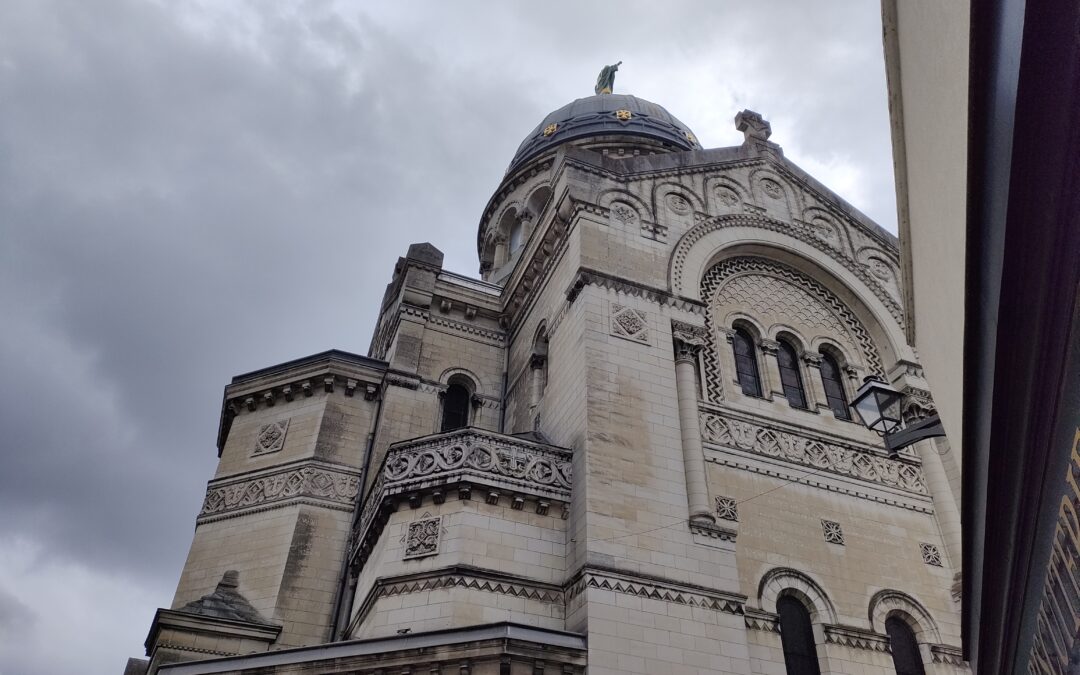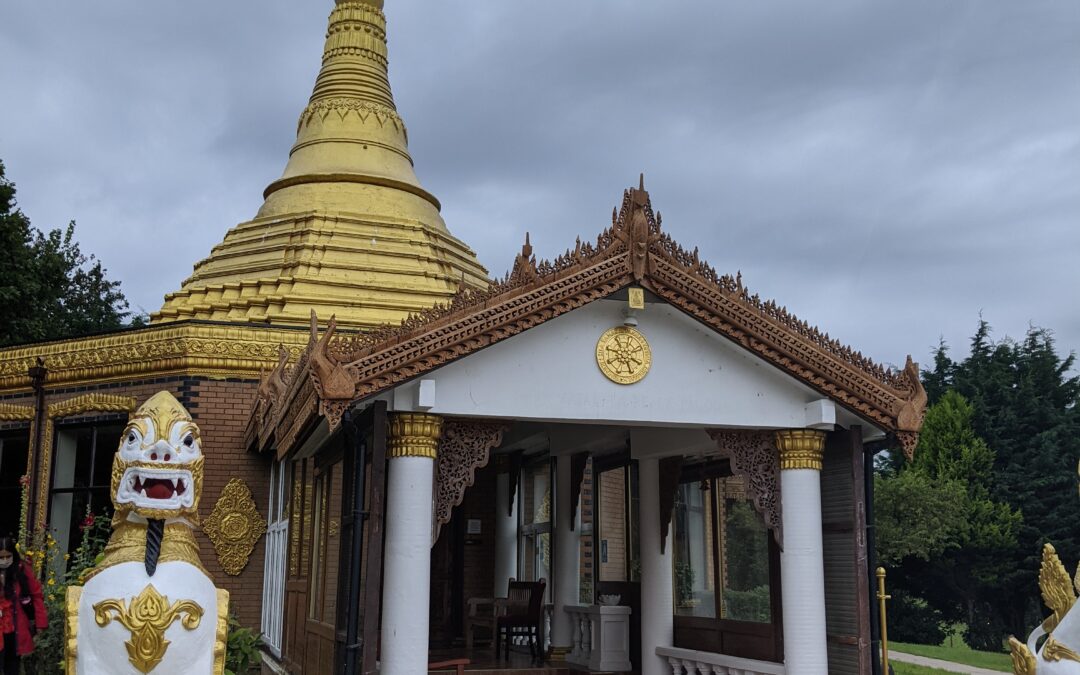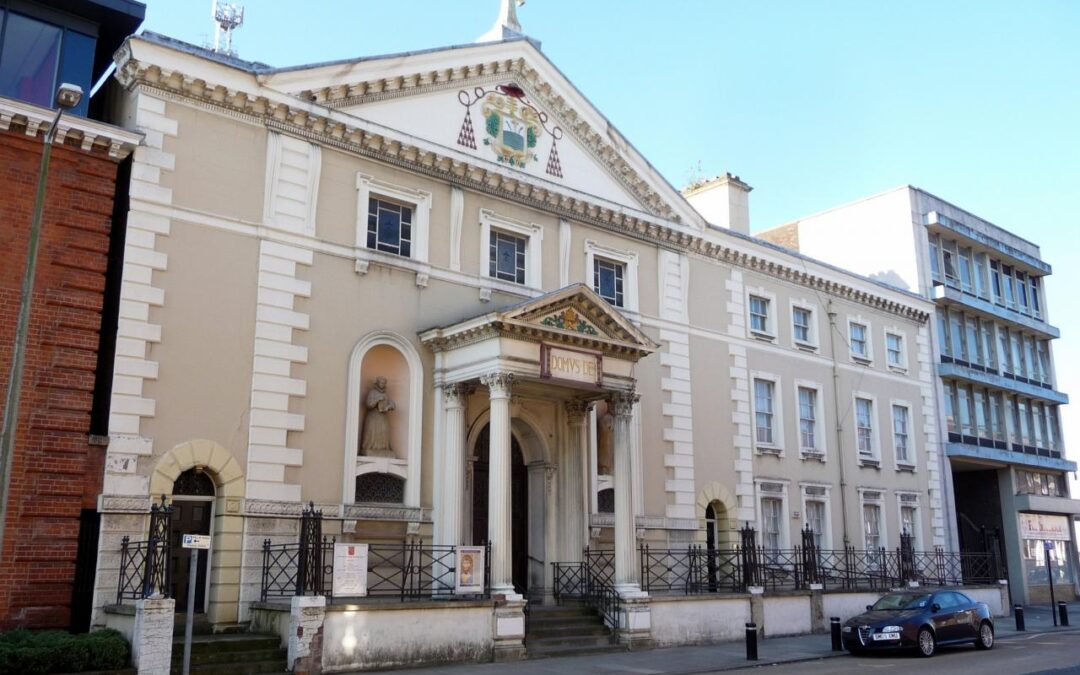
by Cedric | Jul 4, 2022 | General, Miscellaneous
Martin of Tours, also known as Martin the Merciful, was the third bishop of Tours in 371 AD. He has been heralded as the patron saint of the Third Republic of France. The basilica itself was consecrated some 100 years after his appointment, in 471 AD. It began as a monastery under the Abbot of Saint Martin, then becoming a collegiate church under the control of cannons. Regrettably this initial iteration of the church was destroyed during the revolution, but the present church was built between 1886 and 1924 by French architect Victor Laloux. The style in which it is built is neo-Byzantine.

Charlotte tells me that Dominicans are referred to as ‘Dominicanes’ ie: God’s dogs / hounds of the Lord. I have asked her whether I may call myself a Rosary Hound and I think she has given her assent. In any case, being so inclined to pray the rosary, I was of course drawn to the beautiful Mary statue in the back left corner of the basilica. You can see it above. Charlotte and I prayed for a few minutes here before descending into the tomb of St Martin.

The tomb was a restful place, beautifully adorned with marble and a small sepulchre, which I found quite exquisite. Charlotte noted how peaceful the tomb was. What is missing from this photograph is the beautiful stone arches surrounding the tomb itself. The Crypt was beautiful. French families and patrons of the church have paid to have their names put on bricks around the sepulchre. I do not know how I feel about this practice. There was something in the Bible about a den of thieves but one must not be too literal.
I highly recommend you visit this church if you have the time. Tours is a beautiful city, clean and consistent. The basilica was one of our highlights of the trip.

by Cedric | Oct 16, 2021 | General, Miscellaneous
Birmingham Buddhist Vihara and Dhammatalaka Peace Pagoda is the only traditional Myanmar style Pagoda in the Western hemisphere. It is a Buddhist temple in the centre of Birmingham, near the Edgbaston reservoir. During Birmingham Heritage Week, we were able to visit as the Pagoda was open to visitors. We had the opportunity to go inside and speak to one of the monks at length, which was quite illuminating.
The Dhamma Talaka Peace Pagoda was opened in 1998 and is the only such building in traditional Burmese (Myanmar) style in the Western hemisphere. There is a monastery (vihara) where monks reside and a Dhamma teaching hall in the grounds. The Buddhism practised is of Theravada tradition. The pagoda complex is managed by Birmingham Buddhist Vihara Trust, a charitable trust registered with the Charity Commission for England and Wales. Birmingham Heritage Week

The inside of the Peace Pagoda
Once inside, we spoke at length to one of the monks living in the grounds. The monastic life is not for everyone, he told us, but he enjoys the routine of the centre and the time he can devote to his own studies. I was quite moved by the peacefulness of the peace pagoda. Coming from working in commercial law, where restoring our client’s material possessions takes up the majority of our day, to a place which represents the antithesis of my work had quite an effect on me.
The base and walls of the pagoda are octagonal. The interior focuses upon a gold-painted shrine on which there is a large marble statue of the Buddha in meditation posture, sculpted in Burmese style in Mandalay. Images of the Twenty Eight Buddhas were created on site by a Burmese workman and mounted round the inner dome. The entrance is reached by a gabled arcade. Teak doors on three sides of the building are carved with temple guardians and two traditional lion statues at the arcade’s entrance provide protection from evil elements. The inner dome supports a gold-painted stepped spire in the same style as the Shwedagon Pagoda in Yangon, rising to an ornate umbrella feature above which is mounted a crystal bud. Wikipedia

Koi in the pond behind the Pagoda
The grounds contain the monastery but also a Buddhist Academy. There are numerous retreats and lessons available which I hope to take part in. As Buddhism is a philosophy and Catholicism is my religion, I hope trust Jesus will not be vexed by my doing so. Please do go and visit the Pagoda if you can, even if just to see it from outside the grounds.

by Cedric | Oct 8, 2021 | General, Miscellaneous
Nick, my legal crony, whom I visited in Hull, was hesitant to go to the Deep. Whether this be due to the fact he had convinced himself it cost £1000.00 to get in, or that he viewed the activity as childish, I shall never know. However, I am glad that St Nick came to his senses as I was quite keen to go and do a childish activity in otherwise adult Hull. The Deep was founded in 2002 as part of the Millennium Project and is the only one to make a profit, a fact St Nick tells me at every available opportunity. I was deeply, ho ho, impressed with the whole place.

Stamp showing the tip of the Deep
Open since 2002, The Deep operates as an education and conservation charity and in recent years has become an international player in marine conservation. Forging partnerships with key governing bodies, conservation organisations and other reputable zoos and aquariums we are working to make an impact in the protection of our oceans. The Deep

Making new friends
The first impressive part of the Deep was the building itself. I’ll include a photograph below to keep you in suspense but it is a work of architectural genius. On entering, you either climb what feels like 15 flights of stairs or take a lift up to the top floor, and work your way down. The above was one of the first friends we made.

The Deep is home to the UK’s only green swordfish, which I captured in motion above. We asked one of the stewards, (or would you call them fish handlers?) how they stopped the sharks in this large tank form eating the other fish. They told us that they went to extreme lengths to keep each fish species fed on their favourite foods so as to keep them satisfied. However, as with the circle of life, we were told that when some of the older fish get weaker and separate from the group, the sharks tend to pick them off as an extra snack. How moribund!

Blue poison dart frogs
There was a non watery section in the middle of the Deep which included these beautiful poison dart frogs. They were so named because the indigenous people of the Amazon rainforest would coat their spears and darts in the oil secreted from the frogs’ backs, which is rather poisonous. A great sustainable hunting tool.

The spectacular finale of the tour of the Deep included a tunnel under the main aquarium and several viewing spots up and down the main aquarium also. This was particularly wonderful and where we saw the above turtle swimming at us slowly, almost nefariously, possibly trying to out swim the shark.
In all, this was somewhat childish an experience in that it propelled one back to their own childhood when parents, bereft of ideas but able to dispense income, took one to aquariums. Indeed there were myriad children plaguing the place, though we did go on a weekend. This is well worth a visit and two hours of anyone’s time and may be the best thing I have done in Hull sober.

The Deep

by Cedric | Oct 4, 2021 | General, Miscellaneous
Charles Borromeo was the Archbishop of Milan from 1564 to 1584 and a cardinal of the Catholic Church, and has been made so by his uncle, Pope Pius IV, in 1560. He was a key figure in the counter-Reformation movement alongside Phillip Neri and St Ignatius of Loyola (coincidentally St Ignatius is my favourite church in Rome, or at least one of them). I had the pleasure in August of spending a Sunday morning in Hull, where I decided to go to a Catholic church rather than throw caution to the wind and go to the beautiful Minster.

St Charles Borromeo, Hull
From a rather unassuming exterior, perhaps a hallmark of Hull buildings outside of the Old Town or Queen Victoria Square, the interior is something of a miracle. With beautiful features, a resplendent altar and I believe the part above the altar is called an apse. This for me was a glorious explosion of colour and a lovely depiction of the dove of peace.
Saint Charles Borromeo Catholic Church is the mother church for the city of Kingston-Upon-Hull. From out of this community grew all the other parishes in the city which were created as the Catholic population multiplied and expanded.
Built in 1829 it is the oldest post-Reformation Catholic Church in the diocese of Middlesbrough. It is also Grade 1 listed. It was recently included in Elena Curti’s book, ‘Fifty Catholic Churches to See Before You Die’ which explores some of the great architectural treasures of our nation.
…
The present church was built in 1829. However, the church as it is seen today is really due to the work carried out in the late nineteenth century under the direction of Canon William Sullivan. St Charles Hull
Mass times at the time of writing are Sunday 10am and 6.30pm. I would encourage you to visit this lovely church, in the centre of Hull and near the wonderful Hop and Vine pub. I had a great time and was able to see some beautiful art and sculptures.
Its origins go back to 1779 and to chapels in Posterngate, destroyed in the Gordon Riots, and to North Street (1799). The present church was built in 1829 (architect John Earle), widened in 1835 (architect JJ Scholes), and substantially altered in 1894 (architects Smith Brodrick and Lowther). The mission/parish was known in its earlier phases as Saints Peter and Anne and then Saint Augustine. Middlesborough Diocese

by Cedric | Jul 24, 2021 | General, Miscellaneous
After a not very filling meal at Grassington House, we headed to the wonderful Forester’s Arms where we enjoyed a single pint, well I did anyway, being ever fearful of the next days’ cycling. Once we had drunk enough sugary liquid calories and yeast water (cider and beer), we headed to Linton Falls, which is a popular attraction in Grassington / Linton.
The popularity of the waterfall is no doubt due to it being an easy stroll from the National Park car park in Grassington. A footbridge leading from Grassington to Linton spans the fall. It is the fourth bridge to be located in the this spot. The original Tin Bridge was built in 1814 for workers at Linton Mill, the current bridge was built in 1989 after the previous incarnation was closed for being unsafe the previous year. My Yorkshire Dales

The way to Linton Falls from the National Parks carpark
We visited at a time where there was neither great rainfall or great drought. The weather was also free of wind hence our sighting of the falls was serene. See it below from the aforementioned bridge and from below the bridge.

We were extremely lucky with the weather throughout the Way of the Roses. Our evening in Grassington was no different. Quite spectacular.

The walk from the falls back to the Craiglands was equally spectacular. See below the bridge before the hotel on the left. Really beautiful evening.

Overall this was a wonderful evening. We were alone in this beautiful place and were able to enjoy it to the fullest extent. Cannot recommend enough.

by Cedric | Jun 15, 2021 | General, Miscellaneous
In January, I covered the biological basis of the newly emerging COVID-19 vaccines. However, since the vaccine rollout became more widespread, an increasing hesitancy to take the vaccine has arisen. This may be for various reasons, such as COVID infection post-vaccination or simply not trusting the science behind vaccination. If it is the latter, it may be worth disposing of any item in your house made by those in a scientific research background, as they too will have little value to you (paracetamol should be dumped as quickly as possible, for your safety). Scientific research, be it biological, chemical, or physical usually underpins modern medicine. Whether that is research into the way in which the human body works, designing new drugs to treat infection, or invention/refinement of diagnostic machinery. The value of research cannot be understated.
It is important to be clear that vaccinations have never and will never be linked to an overarching plan in which the vaccine is inadvertently used to bring people harm. You have every right to refuse a vaccine but spreading misinformation to those yet to receive it will cause more harm than the vaccine itself. This post will follow on from a previous post “What is the COVID-19 vaccine?”, and address some points raised by people hesitant to receive the vaccine.
Double-vaccinated and still contracted COVID
In early June, I tested positive for COVID-19 and experienced symptoms even after being double vaccinated. As a follow-up to the previous article addressing common misconceptions of the vaccine, it is doubly important to address the narrative that the vaccine is not effective. So, the main question is: How can I be vaccinated, but still get COVID?
There are three administered vaccines within the UK (Oxford-AstraZeneca, Moderna and Pfizer-BioNTech), all follow the same mRNA-vaccine technology as discussed previously, but they each have varying rates of protection. However, the consensus is that after a single dose of the vaccine the likelihood of symptomatic infection decreases by 70% (Bernal et al., 2021), with this likelihood decreasing further after the second dosage. This means you are 70% less likely to be symptomatic. Like all vaccines, they do not offer 100% protection (McNeil, 2020). However, there is an important concept known as cost-effectiveness. This principle balances the cost of the disease against the cost of vaccination (McNeil, 2020). Therefore, if the cost of the vaccine outweighs the cost of the disease the vaccine is unlikely to be administered or researched. In the case of COVID-19, the cost of the disease outweighs the cost of the vaccine. With the COVID-19 vaccine, the rate of hospitalisation decreased by 76% after the first phase of the vaccine rollout in the UK (Lintern, 2021). If that isn’t enough proof that getting the vaccine is a positive thing, let’s delve deeper.
It is completely possible and the case for most vaccines that you can contract the disease after being inoculated, this can be for a range of reasons which you can read up on here: http://vk.ovg.ox.ac.uk/vk/disease-vaccinated-populations
The most relevant factor on this list for COVID is the evolution and changing of the virus itself, the most concerning of the variants is the Delta variant (B.1.617.2). This variant was first found in India and has an increased transmission rate as well as decreasing the vaccine’s efficiency. While the Pfizer-BioNTech vaccine retains 79% effectiveness against the delta variant, Oxford-AstraZeneca’s effectiveness ranges between 60-73% effective (The Covid Delta variant: how effective are the vaccines?, 2021). Therefore, worst-case scenario there is a 40% chance you may still contract COVID-19.
So, should you still get the vaccine? In short, yes. The vaccine prepares your immune system for infection by a COVID virus of a similar kind regardless of strain. Whilst the Delta strain is able to infect due to relative unfamiliarity at first, the vaccine provides your body with the means to deal with it upon recognition. Viruses and all pathogens aim to avoid the immune system. The variants of COVID-19 are able to do exactly that for a short period of time when they arise as a new variant, thus infection. However, once recognised, the body can adapt to the variant quickly and trigger an effective immune response clearing the infection much faster than without. In my case, symptoms included: mild headache, loss of taste and smell, and fatigue.
So, what’s the point if you’re still able to get COVID? The answer is protection against serious symptoms and the condition called long-covid. I recovered from COVID in 5 days, and during that time I was able to function relatively normally. Furthermore, my taste was lost for a maximum of 6 days. Whereas others who suffered from COVID whilst unvaccinated have claimed their sense of smell and taste was lost for a month or even longer (Marshall, 2021). In addition, the vaccine prevents COVID from being able to replicate as much as it would normally within the cells that support your sensory neurones in the nose (responsible for taste and smell), therefore lessening the symptomatic presentation and time it takes for the body to recover.
I trust the above clarifies but Cedric can forward me any further concerns which I shall look into, schedule depending.
Bibliography:
Bernal, J. L., Andrews, N., Gower, C., Robertson, C., Stowe, J., Tessier, E., … & Ramsay, M. (2021). Effectiveness of the Pfizer-BioNTech and Oxford-AstraZeneca vaccines on covid-19 related symptoms, hospital admissions, and mortality in older adults in England: test negative case-control study. bmj, 373.
Guardian, the. 2021. The Covid Delta variant: how effective are the vaccines?. [online] Available at: [Accessed 15 June 2021].
Lintern, S., (2021). Vaccines cut Covid hospitalisations in England by 76%, new research shows. [online] The Independent. Available at: [Accessed 15 June 2021].
Marshall, M. (2021). COVID’s toll on smell and taste: what scientists do and don’t know. Nature, 589(7842), 342-343.
McNeil, S. (2020). Overview of vaccine efficacy and vaccine effectiveness. Canadian Center for Vaccinology. https://www. who. int/infl uenza_ vaccines_plan/resources/Session4_VEffi cacy_VEff ectiveness. PDF.
Vk.ovg.ox.ac.uk. 2020. Disease in vaccinated populations | Vaccine Knowledge. [online] Available at: [Accessed 15 June 2021].




















